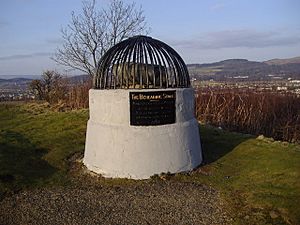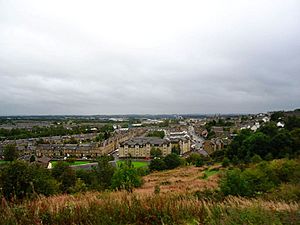Mote Hill facts for kids
Quick facts for kids Mote Hill |
|
|---|---|
| Heiding Hill, Murdoch's Knowe, Hurlie Haw, Hurly-Haaky | |

A view of from Mote Hill towards the Firth of Forth
|
Mote Hill is a famous spot in Stirling, Scotland. It's the northern part of the Gowanhills, which is part of the Royal Park around Stirling Castle. This park has old walls, some built as far back as the 1100s, to keep deer inside. Mote Hill became part of the Royal Park around the year 1500.
Thousands of years ago, Mote Hill was a piece of land sticking out into a huge ancient sea that no longer exists. Across the River Forth from Mote Hill is Abbey Craig, where the National Wallace Monument stands. For many centuries, these two rocky hills were the easiest place to cross the River Forth.
Mote Hill is also known by other names like Heiding Hill, Murdoch's Knowe, or Hurlie Haw. It's famous for the Beheading Stone, which was used for punishments in medieval Stirling. The stone is now on a concrete base and covered by an iron cage. You can still see marks on it from axes used long ago.
Mote Hill is also the site of an ancient vitrified fort. This type of fort was destroyed by fire in the first half of the first thousand years AD. This date was confirmed by an archaeologist named Murray Cook, who works for Stirling Council.
Contents
Ancient Fort on Mote Hill
Mote Hill was once home to an ancient fort built by the Celts. This fort was built high up, looking over the place where people crossed the River Forth.
One day, the fort was destroyed in a huge fire. This fire was so hot that it melted the stones of the fort. When stone melts and then cools, it turns into a glassy material. This is why it's called a vitrified fort.
Mote Hill Through History
Mote Hill has seen many important events over the centuries. It's located along the side of the Castle Rock of Stirling. This area is known as Gowling or Gowan Hill.
During a battle in 1746, Mote Hill was used by soldiers. They set up cannons there to attack Stirling Castle.
The Beheading Stone's Past
The rounded top of Mote Hill is sometimes called the "sad and fatal mound." This is because it was a place where important people faced punishment.
For example, in 1425, the Duke of Albany and his two sons were punished here. The Earl of Lennox, the Duke's father-in-law, also faced the same fate. From Mote Hill, the Duke of Albany could see his own lands one last time.
In 1437, Sir Robert Graham and others involved in the death of King James I were also punished at Stirling. It is believed their punishments ended here on Mote Hill.
The Hurly-Haaky Game
Mote Hill is also known locally as Hurly-Haaky. This name comes from a fun game that King James V used to play here when he was a boy.
The game involved sliding down a steep bank, perhaps on some kind of sled. A writer named Sir David Lindsay mentioned this game.
In the early 1800s, children in Edinburgh played a similar game on Calton Hill. They used a horse's skull as their seat! It's possible that a cow's skull was used for the Hurly-Haaky game on Mote Hill, as "hawky" or "haaky" is an old Scottish word for a cow.
Public Access and Walks
Today, Mote Hill and the surrounding area are open for everyone to enjoy. There are many paths and walks that start here.
You can walk around the base of Stirling Castle Rock. There are also lovely paths along the wooded slopes to the southwest of the old town. The main path in this area is called the Back Walk. It has beautiful trees and was first created in 1724.



